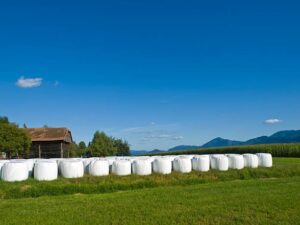Silage plastics are essential components of livestock feed production. Used to cover bunkers and piles of feed from oxygen and moisture exposure, silage plastics help preserve its nutritional value and ensure livestock continue receiving sufficient nourishment.
 Covers may be created using plastic tarps weighted down by tires, which create vast amounts of waste every year and frequently end up in landfills or recycling centres.
Covers may be created using plastic tarps weighted down by tires, which create vast amounts of waste every year and frequently end up in landfills or recycling centres.
Reduced Waste
Reusable silage plastic offers a solution to this dilemma, as it can be reused year after year – eliminating the need for costly nylon oxygen barriers or other temporary covers only intended for one season’s usage. When selecting such an investment cover it’s crucial that it will stand up under continuous use; choosing one which can also withstand repeated washing can save money in the long run.
Traditional silage covers create immense waste. Farmers frequently end up with piles of torn plastic that cannot be reused and ends up polluting soil, water, and air around their farm, becoming hazardous both to their environmental footprint and animal health.
Reusable silage wraps are typically constructed out of low-density polyethylene (LDPE), an eco-friendly plastic that can be recycled time after time. This material makes an excellent material choice as it’s durable enough to keep oxygen at bay – key for high quality silage fodder production. Furthermore, using this kind of cover reduces waste generated from agricultural plastics significantly.
Reduced Cost
Many farmers rely on plastic covers to make silage, from thin films stretched around individual bales to thicker geomembranes on larger piles. Although these covers do the job effectively, their limited-service life and large waste generation mean many now opt for other methods that reduce both cost and waste production. Luckily, many now have a new option that reduces both factors – see next slide for more.
Farmers looking to reduce costs may benefit from using reusable silage plastic instead of traditional single-use plastic. It comes in various thicknesses to suit different types of silage, with reinforced polyethylene (RPE) products from BTL Liners providing excellent chemical and UV resistance as a cover material for their silage cover needs.
Farmers have reported that using reusable silage plastic saves them money in the long run by cutting back on how many covers they purchase, and by decreasing machinery damage and costly repairs. Additionally, this durable liner helps save time on maintenance.
Recycling silage plastic allows them to benefit from a closed-loop system in which plastic waste is returned directly to its manufacturer for recycling into various products. Farmers who choose this technology can install dumpsters at their farm for easy collection and disposal of silage plastic liners.
Increased Durability
Many materials exist to protect silage from UV rays, wind and rain; however, many of these products quickly deteriorate in harsh environments and generate significant waste each year. Dairy farmers understand the environmental implications associated with plastic sheets but struggle to find suitable recycling options or viable replacement covers that have less wasteful solutions available to them.
When selecting a silage cover, look for one made with high-density polymers like RPE that has thick and sturdy material, such as thick RPE films or foil. In addition, an oxygen barrier built into the cover may reduce time and money spent making silage, saving energy and decreasing waste production.
Baled silage may be more expensive than pit silage, but it offers greater flexibility for cutting grazing stock and storing it for the winter. By creating smaller yet denser round bales using a chopper to improve dry matter loss and decrease silage bunker usage across an acre of field, this technique reduces building and operating expenses as well as plastic use per acre.
Recyclable
Low-density polyethylene (LDPE) film agricultural plastics are integral to modern farming as a tool to preserve and protect crops. Furthermore, this reusable silage plastic reduces its impact on the environment – similarly to how glass and aluminium are recycled.
Farmers use LDPE film to wrap hay bales, bunker silo covers, greenhouses and mulch piles on farms; it can also be used as mulch tarps and netting material. When discarding, this waste product is often burned or buried on farms rather than sent directly to landfill.
According to a survey, most farmers who utilise plastic find that disposal is their greatest obstacle when using it. Many have stated they cannot dispose of it themselves on-farm while some report local councils have banned burning or burying of plastic waste.
